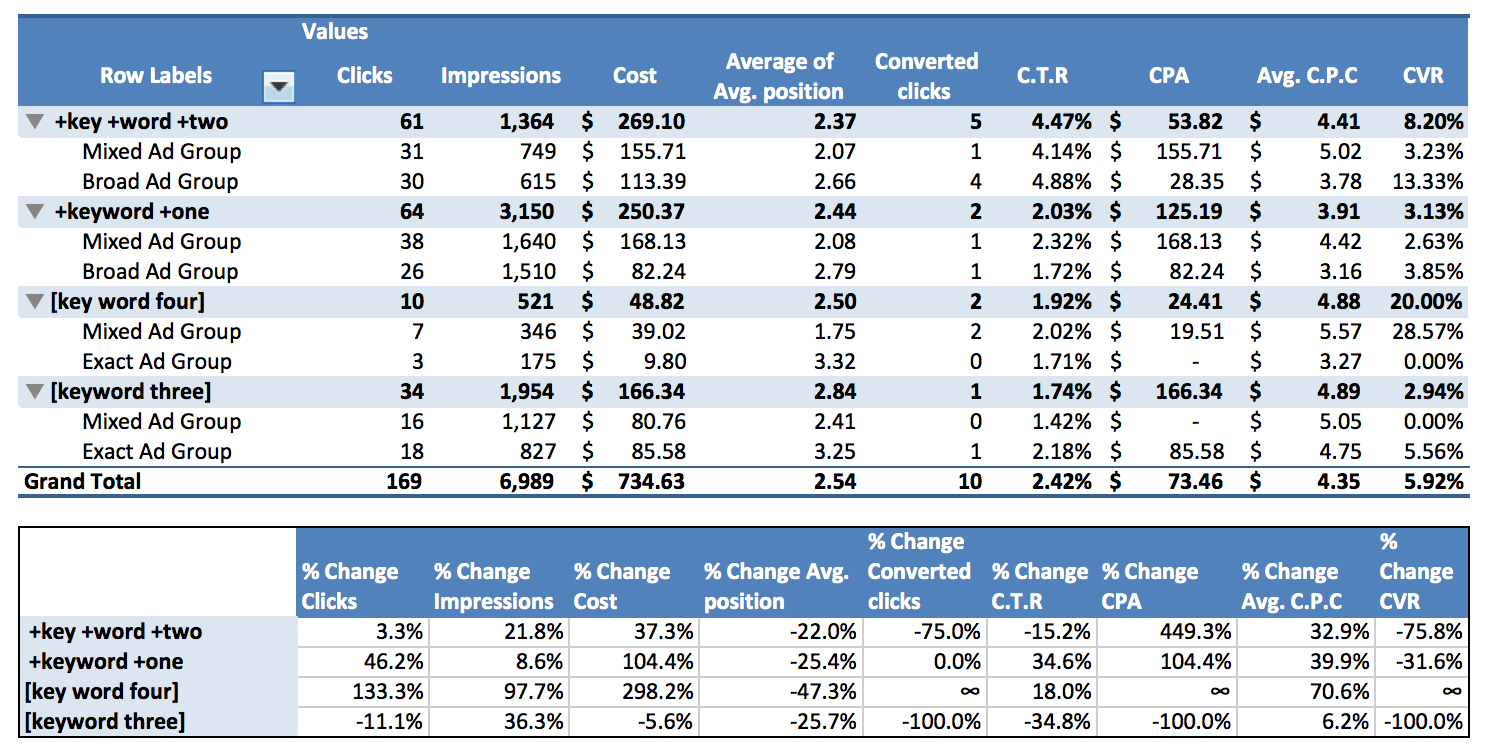Keyword match types are an integral part of how you decide to set up your accounts. Typically this decision is a matter of what the account manager prefers.
We wanted to dig a little deeper and get some numbers behind different structure breakouts. We took a look at ad group breakouts by match type and ones without by testing different segment types in two AdWords accounts. In the first case study two top performing ad groups segmented by match type were combined into one ad group containing both exact and modified broad terms. In the second case study, a campaign that was utilizing mixed match type ad groups was duplicated and ad groups were restructured by match type. The two campaigns were then run side by side.
First we’ll dive into the basics of each structure type, then take a look at case study results.
Segmenting Ad Groups By Keyword Match Type
In this method, ad groups are categorized by theme and match type. For example:

Embedded negatives are added to funnel traffic to the appropriate keyword and ad.
Pros
- Performance by match type is easily visible
- No need to tier your bids
- Better control over DKI ad copy
Cons
- Many ad groups to manage
Tiered Bidding
In this method, different match types are in the same ad group with bids being staggered.
Pros
- Fewer ad groups to manage
Cons
- Varying bid changes. If you’re not careful you can accidentally raise a BMM bid higher than the exact
Campaign Segmentation
In this account structure strategy, match types are broken out by campaign.
Pros
- More effective campaign budget management by match type
- Easy negative keyword management
- Less match type cross pollution
Cons
- Many campaigns to manage
Case Study #1
The Account: Campaigns are grouped by product type, and ad groups are segmented by match type.
The Test: This was a smaller scale test. For the top performing campaign I took the top ad groups and grouped them into a new ad group where broad and exact match types are lumped together. Bids were tiered so that the exact match terms had higher bids. Ad copy was kept the same.
Timeline: Data pulled 6/30/2014 – 7/22/2014 and compared to the previous time period
After match types were mixed into one ad group, CTR and CVR decreased even though average position increased. Conversions decreased, so CPA also saw a significant increase. It’s worth noting that the client requested that bids be increased for these particular keywords, which (at least partially) explains the better average position after the restructure.
If we take a look by match type and judge performance by conversions, exact match keywords appear to perform better in the mixed ad group, while broad tends to do worse in this account.
Case Study #2
The Account: Campaigns grouped by product and state. Ad groups were not segmented by match type and this particular campaign has around 670 keywords.
The Test: One campaign was duplicated and broken out into ad groups by match type. The two campaigns were allowed to run side by side.
Timeline
May 24 – Jun 22: Mixed match type campaign active
Jun 23 – Jul 22: Restructured campaign & mixed campaign active
Results
While the two campaigns were running simultaneously, the campaign segmented by match type had a better average position as well as a higher CTR (1.92% vs. 1.65%). If we break this down by match type we find that splitting out the ad groups gives exact match keywords more room to breathe, increasing their overall impression volume and CTR.
One fact that could have contributed to the results of this test is overall impression volume. The campaign that was restructured did not receive nearly as many impressions as the control campaign, so the results may be skewed.
As far as match type cross pollution goes, we don’t see that there is any major impact from structuring the campaign one way or the other. Broad keywords only had one fewer phrase match query triggering an ad.
Overall Findings
- For both tests, CTR was higher in the ad groups that were segmented by match type (16.2% higher in the large account, 3% higher in the smaller account)
- Conversion volume is harder to judge, as both accounts have low conversion volume.
- Conversion rate dipped after the switch was made to tiered bidding for the smaller scale test.
While it appears that structuring your ad groups by match type results in higher CTRs, we would need to conduct further testing across more accounts to make a definitive statement as to what works best. It’s also worth noting that we have not conducted formal testing for segmenting match type on the campaign level.
Based on these initial numbers it seems as though ad group segmentation by match type is the way to go. This method also has organizational benefits that many account managers prefer. The results of the tests weren’t so far off that I strongly recommend one way or the other. Ultimately I think account managers should structure the account in a way that will allow them to manage it the most efficiently and produce the best results.
Your best bet is to really understand how different match types tend to perform in your account. If you find that exact match keywords bring in more conversions I would continue segmenting by match type.











